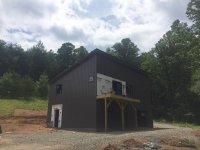I got a good deal on Ipe siding which is T&G and milled with two grooves on the back. Aside from all the complaints about putting a finish on Ipe I am wondering with 1"x3.5" boards no longer than 6 feet if using furring strips are necessary? It's only 150 sf of siding and I would like to keep the siding up against the Tyvek sheathing (fitting under my 1" J-Channel) instead of bringing it out for a rainscreen type system.
Another thought to help minimize some movement is to do some dry fit Dominos on the butt joints between board ends. Does anyone feel like promoting airflow and evaporation behind such a small amount of Ipe siding necessary? Lastly, I was planning on using stainless steel trim head square finish screws to attach all of it.
Thanks
Another thought to help minimize some movement is to do some dry fit Dominos on the butt joints between board ends. Does anyone feel like promoting airflow and evaporation behind such a small amount of Ipe siding necessary? Lastly, I was planning on using stainless steel trim head square finish screws to attach all of it.
Thanks

